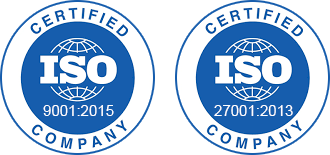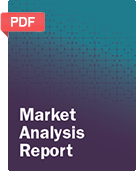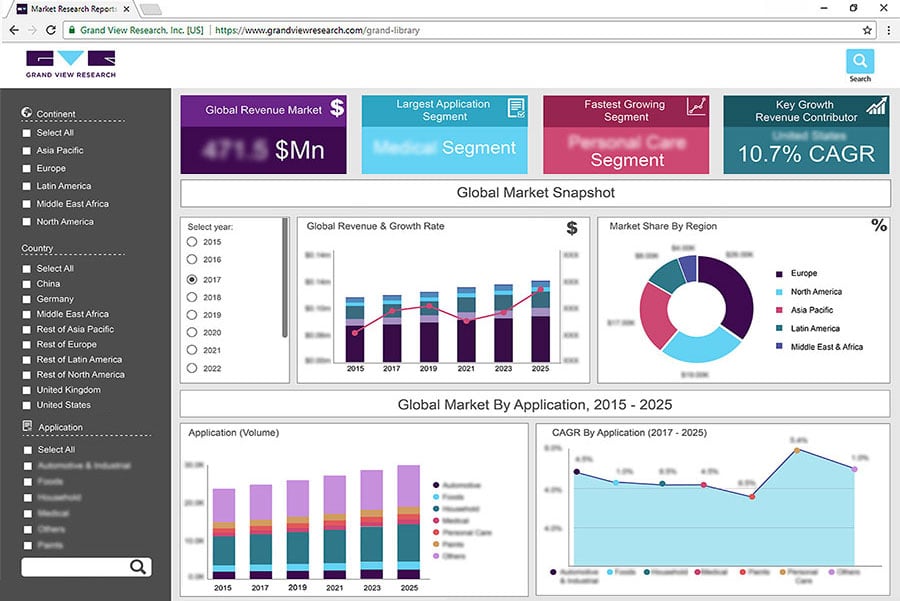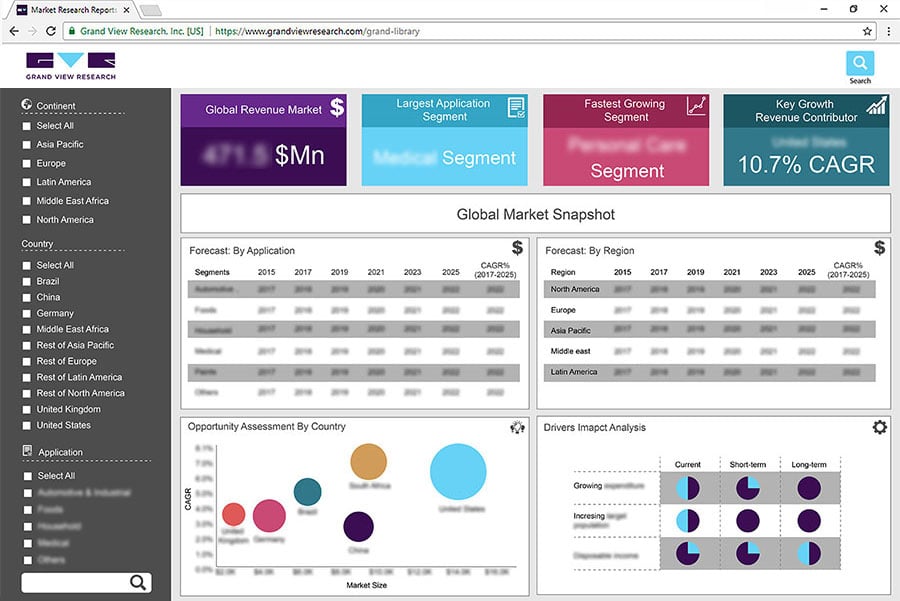- Home
- »
- Advanced Interior Materials
- »
-
Artificial Turf Market Size, Share And Growth Report, 2025GVR Report cover
![Artificial Turf Market Size, Share & Trends Report]()
Artificial Turf Market Size, Share & Trends Analysis Report By Material (Polyethylene, Polypropylene, Nylon), By Application (Residential, Commercial, Sports), By Region, And Segment Forecasts, 2019 - 2025
- Report ID: GVR-3-68038-667-7
- Number of Report Pages: 120
- Format: PDF, Horizon Databook
- Historical Range: 2014 - 2018
- Forecast Period: 2019 - 2025
- Industry: Advanced Materials
Report Overview
The global artificial turf market size to be valued at USD 3.8 billion by 2025 and is expected to grow at a compound annual growth rate (CAGR) of 5.4% during the forecast period. Increasing demand for easy to maintain, durable, and cost-effective flooring products for their use in outdoor applications are the major factors driving the demand for artificial turf.

Application of artificial turf in lawns and playgrounds helps save million gallons of water. These products also eliminate the use of harmful fertilizers and pesticides used for natural grass. Furthermore, they are easy to maintain and replace, which significantly reduces the maintenance cost of users.
Growth of construction sector is a key factor favoring the market in the U.S. Artificial turfs have a high demand in construction projects for houses, sports arenas, stadiums, and commercial gardens. Early acceptance and innovations in the products have further aided the market growth of artificial turfs in the country.
Modern artificial grass contains anti-bacterial properties, which help prevent the spread of bacteria and germs. Furthermore, unlike natural grass, the product is not exposed to hazardous pesticides, which makes it both children and pet friendly. As a result, demand for the product in playgrounds and parks is likely to grow over the projected period.
Schools and sports clubs are likely to be key consumers for the product as it can sustain wear & tear. Increasing sports activities in Asian countries and increasing investments by the governments in playgrounds and sports programs are likely to have a positive impact on the market growth over the projected period.
Growing demand for artificial turf in public spaces for water-saving landscape solutions is expected to drive demand over the projected period. The Synthetic Turf Council represents the players involved in the designing, installation, consulting, and testing of synthetic turf products. Promotional activities by such organizations are likely to boost industry growth.
Artificial Turf Market Trends
Increasing demand for replacing original grass with artificial turf is the prominent factor responsible for fueling the market. Artificial turf is easy to maintain in comparison to the grass, as an inability to grow means that frequent cutting is not required. Moreover, many people have an allergy to grass which can be avoided by using artificial turf. According to the Centres for Disease Control and Prevention, around 19.2 million adults aged 18 years and above were diagnosed with grass allergies or hay fever in the U.S. in 2018.
Rising health awareness has inclined people to indulge in sports activities. This has increased the demand for fully equipped stadiums and sports fields. The surge in demand is expected to further propel market growth. In a global census undertaken by FIFA, around 265 million people play sports. In the United States, around 25% of people take part in sporting activities.
The sunlight refracted from glass surfaces on walls tends to damage the artificial turf. Hence, difficulty in finding the right place for turf installation is anticipated to act as a restraint for the market. However, technological advancements that soften synthetic grass blades such as the “S-like curve” are likely to create opportunities for market growth.
Material Insights
Artificial turf manufactured using polyethylene materials accounted for the largest share of the market in terms of both volume and revenue in 2018 and is anticipated to continue its dominance over the projected period. Superior characteristics of the products such as durability, softness, and resilience are the factors contributing to their increased popularity in end-user applications.
Polypropylene-based artificial turfs are known for their longer lifespan and lower costs and, therefore, acquired a significant share, in terms of consumption, in 2018. However, factors such as harshness of the product on skin, lower resistance to heat, and less durability have restricted its growth in major outdoor sports applications, which, in turn, is hampering the overall market growth.
Nylon-based artificial turfs are stiff and retain their original shape even in extreme athletic applications and in heavy foot traffic areas. These turfs are resistant to high temperatures and prohibit melting. However, their unlikely resemblance to natural grass and high costs have limited their penetration in residential, commercial, and sports applications.
Innovations in materials for long color holding, wear resistance, and high-melting point are further anticipated to ascend the market growth of artificial turf. Firm hold of artificial turfs in outdoor sports is the primary factor considered by manufacturers; hence, they are focusing on innovations in installation techniques and infill materials.
Application Insights
In terms of revenue, sports was the largest application segment for the product in 2018 and is anticipated to grow at a CAGR of 5.2% over the forecast period. Increasing participation in outdoor sports by the young population across the globe has created a scope for the construction of new stadiums and sports fields and, in turn, supported the industry growth.
Development of sports grounds and stadiums for popular outdoor sports including rugby and tennis in the region has aided the market growth. However, in the past few years, a number of football players have suffered from ACL injuries on turf fields, which is limiting their application scope in these applications.
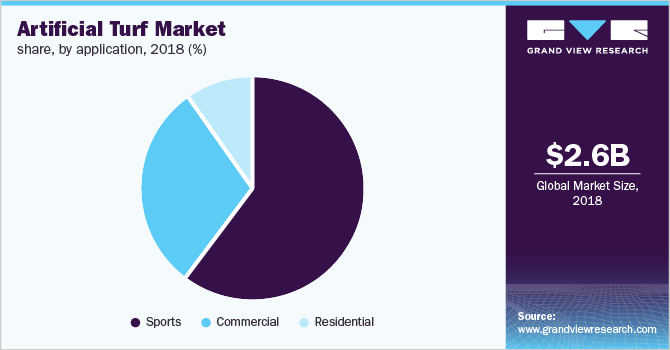
Commercial segment is projected to witness the fastest CAGR of 5.8% over the forecast period. Artificial turfs for commercial applications are widely utilized in public gardens, walkways, amusement parks, and hotels, among other public utility spaces. Growing commercial constructions across the globe are likely to support market growth. Urban development in major geographies and a growing number of commercial playgrounds are anticipated to ascend the growth of artificial turf industry.
Characteristics such as durability, cost-effectiveness, and easy care have contributed to the increasing penetration of the product in residential applications. Residential gardens, lawns, backyards, and terraces are the major end uses of artificial grass. Increasing disposable income levels and rising living standards have supported the demand for artificial turfs in standalone homes.
Regional Insights
Europe accounted for a major share of the market, in terms of revenue, globally in 2018 and is anticipated to grow at a significant rate over the projected period. Presence of a large number of sports fields, switching trends from natural grass to synthetic grass, and increasing popularity of outdoor sports are expected to upkeep the market growth for artificial turf in the region.
The market for artificial turf in France is anticipated to register growth at a CAGR of 4.5%, in terms of revenue, over the projected period owing to increasing installation of turfs on rugby fields. Also, the rising adoption of the product in residential and commercial constructions in the country is further anticipated to support the product demand.
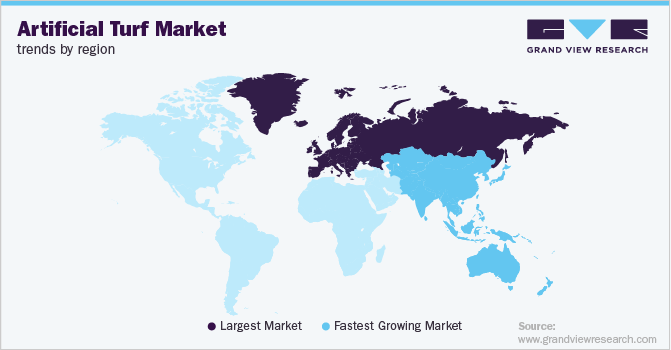
Asia Pacific is projected to register a growth rate of 5.7%, in terms of volume, over the forecast period owing to increasing constructions backed by rising investments from foreign multinationals. Developing tourism and hospitality industries are the major drivers triggering the consumption of the product in commercial applications. Moreover, growing constructions for commercial playgrounds and rapid urbanization are likely to support market growth.
The construction industry in Central & South America is likely to witness growth on account of increasing investments from foreign and domestic players in Brazil, Argentina, Columbia, Chile, and Peru. The market for artificial turf in the Middle East & Africa is expected to register growth on account commercial construction development across the region and the upcoming FIFA World Cup in Qatar.
Key Companies & Market Share Insights
The global artificial turf market is moderately competitive owing to the presence of multinational manufacturers and a large number of domestic players supplying application-specific products. The players, while investing in R&D, majorly focus on the improvement of the product’s durability and lifespan to sustain in the competitive environment.
Marketing strategies adopted by industry players include the production of artificial turfs that have a good quality and are approved by FIFA, FIH, ITF, etc. Moreover, key players focus on business strategies such as contracts and joint ventures to penetrate into the market. Tarkett S.A., CCGrass, TenCate Grass, and SYNLawn are among the major players competing in the industry.
Recent Developments
-
In June 2023, the MHC Weesp, a hockey club near Amsterdam manufactured a unique, dry, and artificial turf surface. This club is the first in the world to have a full-size hockey field based on TenCate's zero-water artificial turf technology.
-
In May, 2023, SYNLawn Artificial Turf featured outdoor amphitheater built for new town square. The designs of the town square included the amphitheater building & outdoor lawn for concerts, & other festivities; a community playground with a splash pad; and fire pits for socializing.
-
In January 2022, The Recreational Group was acquired by Sentinel Capital Partners, an American private equity firm which was further combined with Controlled Products, a leading manufacturer of premium synthetic turf products.
-
In February 2021, SYNLawn, a US-based artificial grass manufacturer, unveiled its new artificial turf’s enhancements and offerings, including commitments to sustainability with more soy content, additional color options, advanced drainage, and Super Yarn technology.
-
In september 2022, TenCate Grass, a Dutch company that manufactures, markets and installs synthetic turf for sports and landscape use, has announced the launch of a program in the United States to recycle used artificial turf.
Artificial Turf Market Report Scope
Report Attribute
Details
Market size value in 2019
USD 2765.6 billion
Revenue forecast in 2025
USD 3808.9 billion
Growth Rate
CAGR of 5.4% from 2019 to 2025
Base year for estimation
2018
Historical data
2014 - 2017
Forecast period
2019 - 2025
Quantitative units
Revenue in USD billion and CAGR from 2019 to 2025
Report coverage
Revenue forecast, company ranking, competitive landscape, growth factors, and trends
Segments covered
Material, application, region
Regional scope
North America; Europe; Asia Pacific; Central & South America; Middle East & Africa
Country scope
U.S., Canada, Mexico, U.K., Germany, Spain, France, Italy, Russia, China, Japan, India, South Korea, Singapore, Australia, Brazil, Argentina, Saudi Arabia, UAE
Key companies profiled
Tarkett S.A., CCGrass, TenCate Grass, and SYNLawn.
Customization scope
Free report customization (equivalent up to 8 analysts working days) with purchase. Addition or alteration to country, regional & segment scope.
Pricing and purchase options
Avail customized purchase options to meet your exact research needs. Explore purchase options
Global Artificial Turf Market Segmentation
This report forecasts revenue growth at the global, regional, and country levels and provides an analysis on the industry trends in each of the sub-segments from 2014 to 2025. For the purpose of this study, Grand View Research has segmented the global artificial turf market report on the basis of material, application, and region:
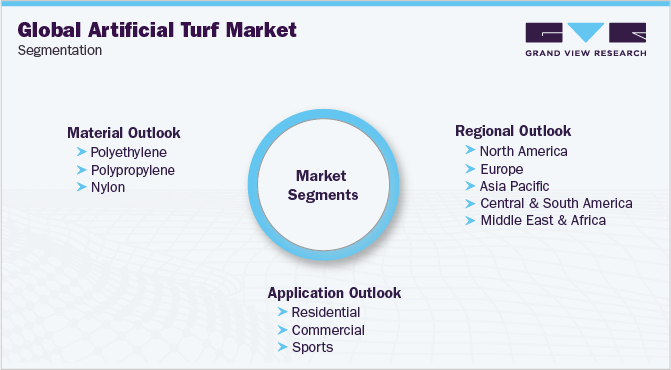
-
Material Outlook (Volume, Million Sq. Meters; Revenue, USD Million, 2014 - 2025)
-
Polyethylene
-
Polypropylene
-
Nylon
-
-
Application Outlook (Volume, Million Sq. Meters; Revenue, USD Million, 2014 - 2025)
-
Residential
-
Commercial
-
Sports
-
-
Regional Outlook (Volume, Million Sq. Meters; Revenue, USD Million, 2014 - 2025)
-
North America
-
The U.S.
-
Canada
-
Mexico
-
-
Europe
-
The U.K.
-
Germany
-
Spain
-
Italy
-
France
-
Russia
-
-
Asia Pacific
-
China
-
Japan
-
India
-
South Korea
-
Singapore
-
Australia
-
-
Central & South America (CSA)
-
Brazil
-
Argentina
-
-
Middle East & Africa (MEA)
-
Saudi Arabia
-
UAE
-
-
Frequently Asked Questions About This Report
b. The global artificial turf market size was estimated at USD 2,765.6 million in 2019 and is expected to reach USD 2,909.2 million in 2020.
b. The global artificial turf market is expected to grow at a compounded annual growth rate of 5.4% from 2019 to 2025 to reach USD 3,808.9 million in 2025.
b. Asia Pacific dominated the artificial turf market with a share of 33.8% in 2019. Developing tourism and hospitality industries are the major drivers triggering the consumption of the product in commercial applications.
b. Some key players operating in the artificial turf market include Tarkett S.A., CCGrass, TenCate Grass, and SYNLawn.
b. Key factors driving the artificial turf market growth include increasing demand for easy to maintain, durable, and cost-effective flooring products for their use in outdoor applications.
Share this report with your colleague or friend.
![gvr icn]()
NEED A CUSTOM REPORT?
We can customize every report - free of charge - including purchasing stand-alone sections or country-level reports, as well as offer affordable discounts for start-ups & universities. Contact us now
![Certified Icon]()
We are GDPR and CCPA compliant! Your transaction & personal information is safe and secure. For more details, please read our privacy policy.
We are committed towards customer satisfaction, and quality service.
"The quality of research they have done for us has been excellent."
